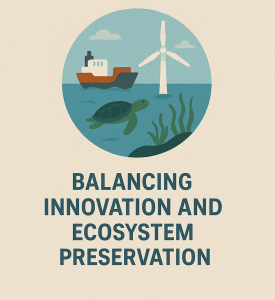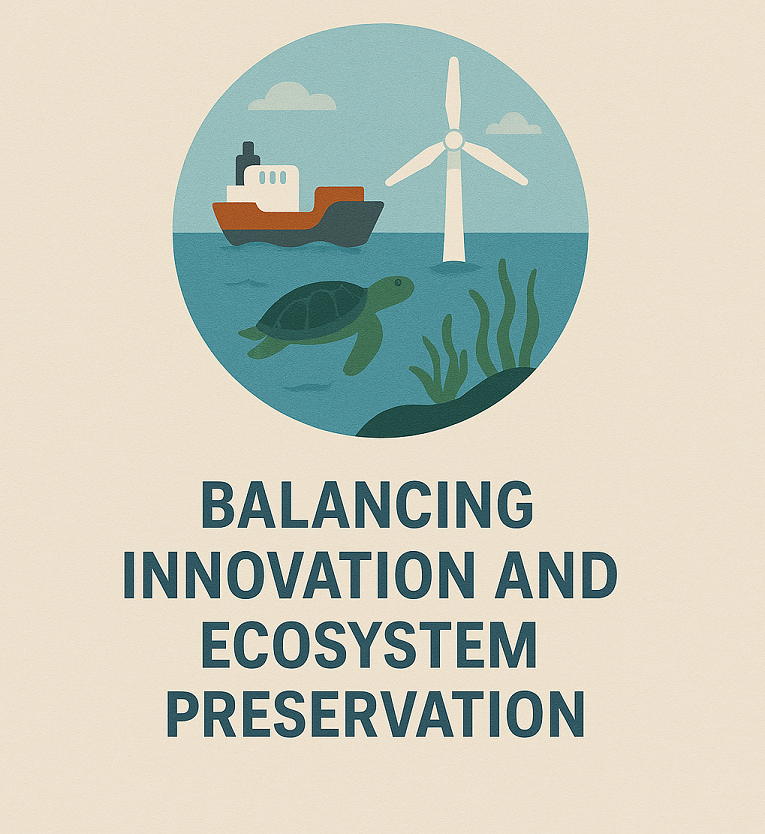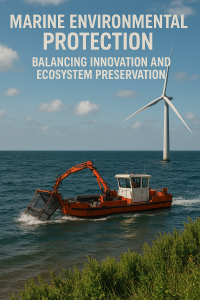Explore the importance of marine environmental protection. Learn how ocean energy devices impact marine habitats and how sustainable fishing practices are helping preserve biodiversity. A comprehensive guide for students, professionals, and ocean enthusiasts.
Can We Power the Ocean Without Harming It?
With over 70% of the Earth’s surface covered by oceans, these ecosystems play a vital role in regulating our climate, providing food, and supporting global biodiversity. As we increasingly look to the sea for energy and resources, a critical question arises:
👉 How can we balance marine development with environmental protection?
In this article, we’ll explore the environmental impact of ocean energy devices, the importance of sustainable fishing practices, and the latest research and strategies shaping the future of marine conservation.
–
What Is Marine Environmental Protection?
Marine environmental protection refers to the collective efforts aimed at preserving and restoring the health of ocean ecosystems by mitigating human-induced threats. These threats include pollution (such as plastic waste, oil spills, and chemical runoff), overfishing, habitat destruction (like coral reef degradation and coastal development), and the escalating impacts of climate change (including ocean acidification, rising sea temperatures, and sea-level rise). Marine environmental protection involves safeguarding ocean ecosystems from human-induced threats, including pollution, overfishing, habitat destruction, and climate change. It also involves promoting sustainable marine industries—like fishing and ocean energy—that coexist with nature.
Core Goals Include:
-
🌱 Preserving marine biodiversity
-
🐠 Preventing habitat degradation
-
🌊 Reducing ocean pollution
-
⚡ Managing the environmental impacts of new technologies
–
Ocean Energy Devices and Marine Ecosystems
Why Ocean Energy?
The growing demand for clean, renewable energy has led to the rapid development of wave, tidal, and offshore wind energy as sustainable alternatives to fossil fuels. These technologies harness the immense power of the ocean, offering a way to reduce greenhouse gas emissions and combat climate change. However, while ocean energy presents a promising solution for a greener future, its deployment is not without ecological consequences. The installation, operation, and maintenance of these devices can have significant effects on marine life and habitats, necessitating careful planning and mitigation strategies.
Why Ocean Energy?
Ocean energy is a critical component of the global transition to renewable power. Unlike fossil fuels, which contribute to pollution and climate change, wave, tidal, and offshore wind systems generate electricity with minimal carbon emissions. The ocean provides a vast, largely untapped energy resource—waves, tides, and winds are predictable and abundant, making them reliable sources of clean power. Additionally, offshore energy projects can reduce land-use conflicts, as many coastal and open-ocean installations operate far from densely populated areas.
Potential Impacts on Marine Ecosystems
Despite their environmental benefits, ocean energy devices can interact with marine ecosystems in ways that pose risks to marine life. The construction of offshore wind farms, for example, may disrupt seabed habitats through the installation of turbines and underwater cables. Noise pollution from pile-driving during construction can interfere with marine mammals’ communication and navigation, while rotating turbine blades may pose collision risks for birds and bats.
Tidal energy systems, which rely on the movement of water to generate power, can alter local currents and sediment transport, potentially affecting benthic (seafloor) ecosystems and fish migration patterns. Similarly, wave energy converters, which float on or near the ocean’s surface, might create obstacles for marine animals or change wave dynamics in ways that impact coastal erosion and sediment deposition.
🌊 Environmental Concerns:
-
Habitat disruption during construction of underwater cables and turbines
-
Noise pollution affecting marine mammals’ communication and navigation
-
Collision risks for fish and sea turtles with rotating turbines
-
Changes in sediment flow and coastal erosion
📈 According to the IEA-OES (International Energy Agency – Ocean Energy Systems), studies show most impacts are localized, but long-term cumulative effects require close monitoring.
 To minimize ecological harm, researchers and engineers are developing environmentally friendly designs, such as quieter installation techniques, turbine designs that reduce collision risks, and strategic placement of devices to avoid critical habitats. Regulatory frameworks and environmental impact assessments (EIAs) play a crucial role in ensuring that ocean energy projects are developed responsibly. Collaboration between scientists, industry leaders, and policymakers is essential to balance the urgent need for renewable energy with the protection of marine biodiversity.
To minimize ecological harm, researchers and engineers are developing environmentally friendly designs, such as quieter installation techniques, turbine designs that reduce collision risks, and strategic placement of devices to avoid critical habitats. Regulatory frameworks and environmental impact assessments (EIAs) play a crucial role in ensuring that ocean energy projects are developed responsibly. Collaboration between scientists, industry leaders, and policymakers is essential to balance the urgent need for renewable energy with the protection of marine biodiversity.
By advancing eco-conscious technologies and implementing strong conservation measures, ocean energy can become a cornerstone of a sustainable energy future—one that powers human societies while preserving the health and resilience of marine ecosystems.
–
🧪 Mitigation Strategies Underway
-
Environmental Impact Assessments (EIAs) before installation: EIAs are conducted before any offshore infrastructure is installed to evaluate potential effects on marine ecosystems. These assessments guide decision-making and ensure that developers take precautionary measures to avoid or minimize environmental damage.
-
Turbine design modifications to reduce risks to marine species: Innovative turbine designs now incorporate features that reduce harm to marine wildlife. For example, slower-spinning blades or shrouded turbines can decrease the risk of collision for fish, turtles, and marine mammals, helping align technology with ecological safety.
-
Acoustic monitoring to track effects on marine mammals: Offshore projects often produce underwater noise, which can disturb marine mammals. Acoustic monitoring systems are deployed to track these sound levels and assess behavioral impacts on species like whales and dolphins, informing adaptive management practices.
-
Marine spatial planning to avoid sensitive habitats: Marine spatial planning (MSP) helps designate where human activities can safely take place at sea. By identifying and avoiding ecologically sensitive areas such as coral reefs or breeding zones, MSP supports the coexistence of marine development and biodiversity conservation.
-
Biofouling-resistant materials to prevent ecosystem disturbance: Materials used in offshore structures are now being developed to resist biofouling—the accumulation of organisms on surfaces. These eco-friendly coatings reduce the spread of invasive species and maintain the ecological balance of marine environments.
💬 “The goal isn’t just green energy — it’s blue energy that respects the ocean.” — Dr. Laura Weinstein, Marine Ecologist
–
🎣 Sustainable Fishing Practices: Protecting Biodiversity
With over 30% of global fish stocks overexploited, sustainable fishing practices have become essential to safeguard marine biodiversity and ensure long-term food security. These practices aim to create a balance between human needs and ecosystem preservation. Sustainable fishing is key to reversing this trend.
What Is Sustainable Fishing?
Sustainable fishing involves methods that avoid depleting fish populations, reduce damage to marine ecosystems, and support the socio-economic wellbeing of coastal communities. It’s about harvesting seafood responsibly while ensuring future generations can do the same. It refers to fishing methods that:
- Avoid overexploitation
- Minimize bycatch and ecosystem harm
- Allow fish populations to regenerate naturally
- Support local livelihoods and indigenous practices
Common Sustainable Fishing Techniques
From selective gear that targets only specific species to seasonal closures that protect fish during breeding, sustainable fishing uses a variety of tools. Quotas, catch limits, and the establishment of Marine Protected Areas (MPAs) also play key roles in preserving marine life and maintaining healthy fish populations.
| Technique | Description | Benefit |
|---|---|---|
| Selective Gear | Equipment that targets specific species and sizes | Reduces bycatch |
| Seasonal Closures | No-fishing periods during breeding seasons | Allows recovery |
| Quotas & Catch Limits | Legal limits on how much can be caught | Controls overfishing |
| Marine Protected Areas (MPAs) | Zones where fishing is restricted or banned | Biodiversity preservation |
–
🌐 Global Movements Supporting Ocean Conservation
International efforts are growing to protect the oceans. Initiatives like the UN’s SDG 14, the Marine Stewardship Council (MSC) certification, and policies under the EU Common Fisheries Policy help enforce sustainable practices. Organizations such as Oceana and WWF are also driving change through advocacy and awareness.
UN Sustainable Development Goal 14: Life Below Water
Marine Stewardship Council (MSC): Certification for sustainably sourced seafood
Oceana & WWF: Advocacy and campaigns for marine policy reform
EU Common Fisheries Policy (CFP): Regulates EU fishing fleets for sustainability
📊 2024 saw a 12% increase in MSC-certified fisheries, signaling growing industry commitment.
–
🔮 Future Outlook: Technology Meets Ecology
What’s Next in Marine Environmental Protection?
Emerging technologies are transforming ocean conservation. AI systems monitor marine ecosystems, smart buoys detect harmful noise levels, and underwater drones provide real-time data on habitat changes. These tools help scientists and policymakers respond faster and more effectively to ecological threats.
What’s Next in Marine Environmental Protection?
- 📡 AI-based marine monitoring systems
- 🐬 Smart buoys tracking noise levels near energy sites
- 📷 Underwater drones used for real-time habitat surveillance
- 🧬 Genomic tools to assess marine species health
Education and Policy Will Be Key
Engaging students, fishers, policymakers, and industries in conservation through awareness, training, and regulation will shape the next chapter in ocean protection.
–
🧭 Real-World Applications & Case Studies
Across the globe, real-world examples demonstrate the success of integrated conservation efforts. From offshore wind farms with adaptive management systems to fisheries co-managed with local communities, these case studies provide replicable models for protecting the ocean while supporting sustainable development.
-
Scotland: Co-location of tidal turbines and MPAs successfully minimizes environmental impact
-
Philippines: Community-led sustainable fishing zones reviving coral reefs
-
Portugal: Waveroller project includes habitat restoration efforts near device sites
-
U.S. West Coast: Use of exclusion zones and observer programs in fisheries
–
❓ FAQs – People Also Ask
❓How do ocean energy devices affect marine animals?
They can disrupt navigation and behavior through noise, electromagnetic fields, or direct collisions, especially during installation phases.
❓Is offshore wind energy bad for the environment?
Not inherently. With proper planning and mitigation strategies, its impact can be minimized and often offset by reduced fossil fuel usage.
❓What are the best sustainable fishing methods?
Techniques that are selective, seasonal, and quota-based—combined with marine reserves—are widely considered effective.
❓What role do governments play in marine protection?
Governments regulate fishing licenses, enforce marine laws, establish MPAs, and fund research for marine ecosystem conservation.
–
✅ Conclusion
Marine environmental protection isn’t just the responsibility of scientists or policymakers — it’s a global mission. Whether you’re a student, fisherman, maritime professional, or environmentalist, your actions contribute to the ocean’s health.
By embracing sustainable fishing practices and carefully integrating ocean energy technologies, we can power our planet without compromising marine life.
📚 References & Further Reading
By: Reza Karimpour, PhD.


